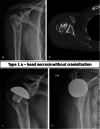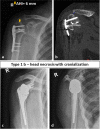Treatment of avascular necrosis of the humeral head - Postoperative results and a proposed modification of the classification
- PMID: 35477459
- PMCID: PMC9047346
- DOI: 10.1186/s12891-022-05338-1
Treatment of avascular necrosis of the humeral head - Postoperative results and a proposed modification of the classification
Abstract
Background: Avascular necrosis of the humeral head after proximal humeral fracture i.e. type 1 fracture sequelae (FS) according to the Boileau classification is a rare, often painful condition and treatment still remains a challenge. This study evaluates the treatment of FS type 1 with anatomic and reverse shoulder arthroplasty and a new subclassification is proposed.
Methods: This single-center, retrospective, comparative study, included all consecutive patients with a proximal humeral FS type 1 treated surgically in a four-year period. All patients were classified according to the proposed 3 different subtypes. Constant score (CS), Quick DASH score, subjective shoulder value (SSV) as well as revision and complication rate were analyzed. In the preoperative radiographs the acromio-humeral interval (AHI) and greater tuberosity resorption were examined.
Results: Of 27 with a FS type 1, 17 patients (63%) with a mean age of 64 ± 11 years were available for follow-up at 24 ± 10 months. 7 patients were treated with anatomic and 10 with reverse shoulder arthroplasty. CS improved significantly from 16 ± 7 points to 61 ± 19 points (p < 0.0001). At final follow-up the mean Quick DASH Score was 21 ± 21 and the mean SSV was 73 ± 21 points. The mean preoperative AHI was 9 ± 3 mm, however, 8 cases presented an AHI < 7 mm. 4 cases had complete greater tuberosity resorption. The complication and revision rate was 19%; implant survival was 88%.
Conclusion: By using the adequate surgical technique good clinical short-term results with a relatively low complication rate can be achieved in FS type 1. The Boileau classification should be extended for fracture sequelae type 1 and the general recommendation for treatment with hemiarthroplasty or total shoulder arthroplasty has to be relativized. Special attention should be paid to a decreased AHI and/or resorption of the greater tuberosity as indirect signs for dysfunction of the rotator cuff. To facilitate the choice of the adequate prosthetic treatment method the suggested subclassification system should be applied.
Keywords: Anatomic shoulder arthroplasty; Fracture sequelae; Proximal humeral fracture; Reverse shoulder arthroplasty.
© 2022. The Author(s).
Conflict of interest statement
Lars-Johannes Lehmann and Christian Gerhardt are consultants for Arthrex and DJO. Jonas Schmalzl, Annika Graf, Michael Kimmeyer and Fabian Gilbert have no competing interest to disclose.
Figures




References
-
- Boileau P, et al. Proximal humerus fracture sequelae: impact of a new radiographic classification on arthroplasty. Clin Orthop Relat Res. 2006;442:121-30. - PubMed
-
- Moineau G, McClelland WB, Trojani C, Rumian A, Walch G, Boileau P. Prognostic factors and limitations of anatomic shoulder arthroplasty for the treatment of posttraumatic cephalic collapse or necrosis (type-1 proximal humeral fracture sequelae) J Bone Jt Surg - Ser A. 2012;94:2186–2194. doi: 10.2106/JBJS.J.00412. - DOI - PubMed
MeSH terms
LinkOut - more resources
Full Text Sources
Medical

